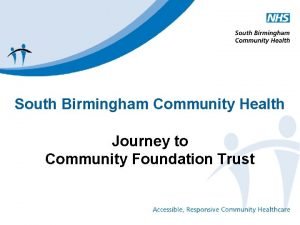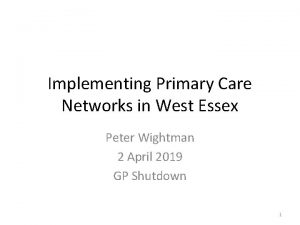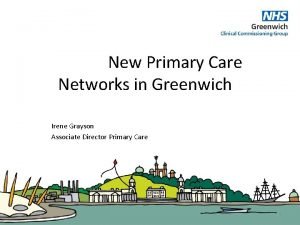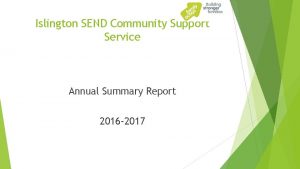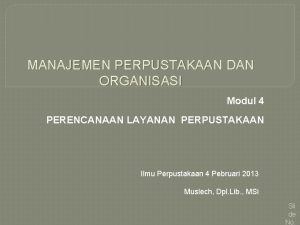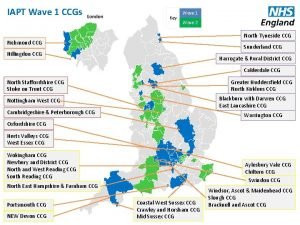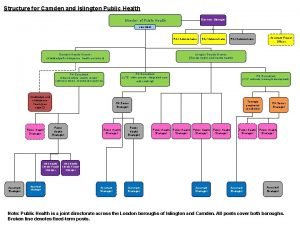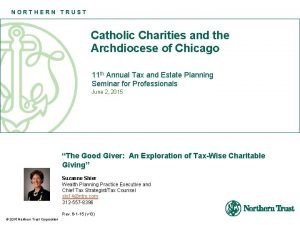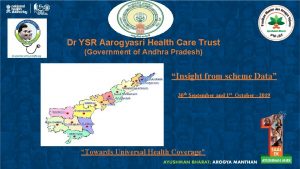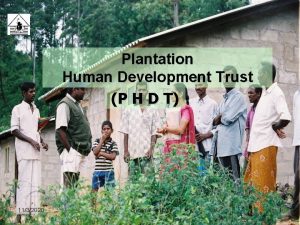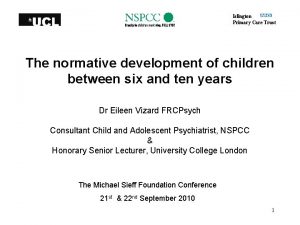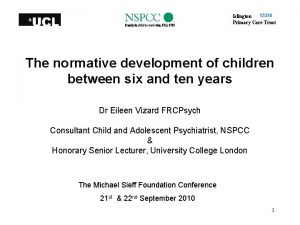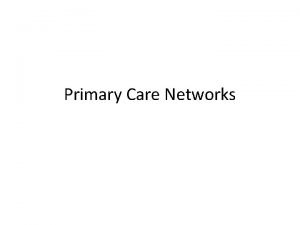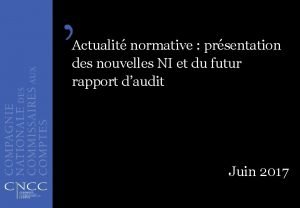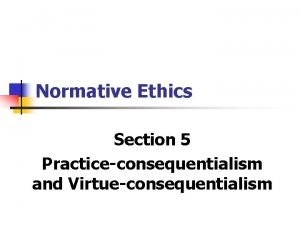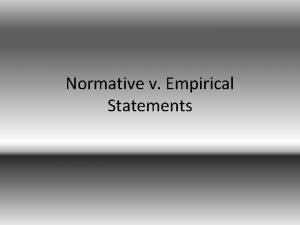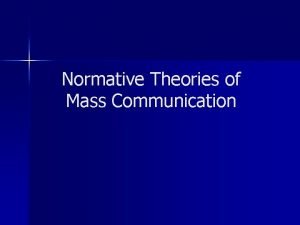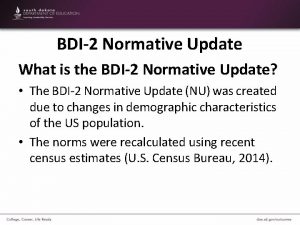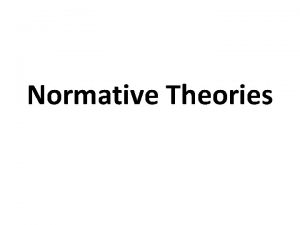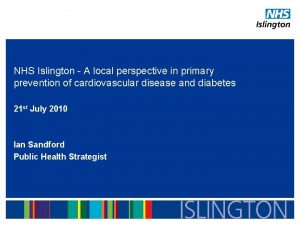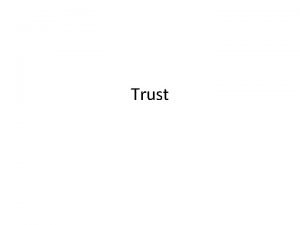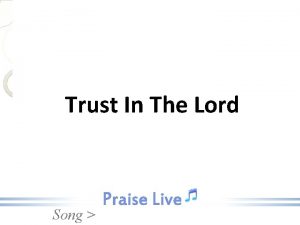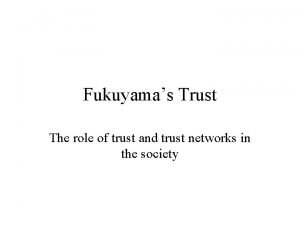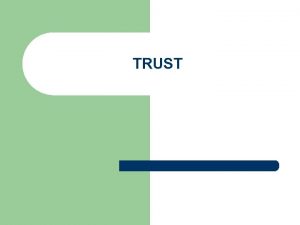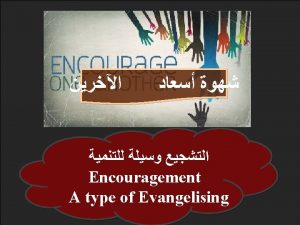Islington Primary Care Trust The normative development of















































- Slides: 47

Islington Primary Care Trust The normative development of children between six and ten years Dr Eileen Vizard FRCPsych Consultant Child and Adolescent Psychiatrist, NSPCC & Honorary Senior Lecturer, University College London The Michael Sieff Foundation Conference 21 st & 22 nd September 2010 1

Outline of Presentation • • • Lifespan Development Child & Environment Child Developmental models Normative Child Developmental Milestones Assessment of Child Development 2

Ontogeny recapitulates phylogeny’ Ernst Haeckel(1866) Thomas Huxley (1868) 3

Lifespan Development • Some truth in these early theories but Haeckel’s theory largely discredited • However, brain development stages may recapitulate human brain evolution: • ‘ “Inside-out” and “Bottom-up” • Higher/Complex areas control the more reactive primitive lower parts of the brain—less reactive, more thoughtful and less impulsive • Lower-Excitatory • Higher-Modulating’ De Brito 2009 4

Lifespan Development 5

8 Ages of Man Erikson 1950 Ego Integrity vs Despair H Maturity G Generativity vs stagnation Adulthood F Intimacy vs Isolation Young Adulthood E Identity vs Role confusion Puberty D Industry vs Inferiority Latency C Locomotor -genital Initiativ e vs guilt B Muscularanal Autonomy vs Shame, doubt A Oral sensory Basic trust vs mistrust 6

Lifespan Development • Lifespan process of change Rutter & Rutter 1993 • Much development occurs in early childhood and adolescence Steinberg & Schwartz 2000; RCPsychs 2006 • Brain development continues in young adult life Blakemore & Choudhury 2006 7

Child & Environment Societal Community Relationship Individual 8

Child & Environment What do we know about links between: • ‘Nature’ (brain development) • ‘Nurture’ (environment – abuse & neglect/care & protection) • ‘Resilience’ (child) 9

Child & Environment Brain development De Brito 2009 • ‘The maturation of grey matter is best described as a constant “push and pull”. New pathways grow, while others are pruned back • Pruning is greatly influenced by experience, so it really is a case of “use it or lose it”! • This makes the brain extremely versatile, and able to Make changes depending on the demands of the environment. ’ 10

Child & Environment Brain development De Brito 2009 • ‘Windows of vulnerability = critical time during which brain hones particular skills or functions • Different windows for different brain regions • If the chance to practise a skill is missed during The window, a child may never learn it (or be impaired) ‘ 11

Child & Environment Studies show adverse effects on the developing brain from abuse and neglect on: • Brain structure • Brain function Mc. Crory et al 2010 But. . . there is also evidence of ‘catch up’ with brain development when ‘nurture’ improves And. . . child resilience moderates between nature and nurture 12

13

Normative Child Development • Positive developmental change occurs across the lifespan notably birth to mid twenties • Will these developmental changes occur regardless (are they hard wired) or can the environment impact on child development? • Why do some children survive & recover from major traumas but others succumb? 14

Attachment Theory John Bowlby 1907 -1990 Child Psychiatrist, Psychoanalyst Animal ethology model for mother child attachment relationships Psychoanalytical theory to understand the emotional aspects of attachment Separation & loss impact ‘A 2 year old goes to the Hospital’ Bowlby, Robertson & Rosenbluth 1952 15

Child Developmental Models: Attachment Theory Attachment is: Any form of behaviour that results in a person attaining or maintaining proximity to some other differentiated and preferred individual, usually conceived as stronger and wiser Bowlby, 1973 16

Child Developmental Models: Attachment Theory ‘The photograph shows an infant rhesus monkey with two artificial mothers to which it can cling (see p. 74). It has chosen the on the right which is covered with a soft towelling in preference to the on the left made of wire. Both are pivoted so that the weight of the monkey depresses a switch and the amount of time spent clinging to each can be recorded. ’ Broadhurst 1963 17

‘In the photograph on the right, the infant rhesus monkey is shown demonstrating the greater importance of mother – infant contact over food (see p. 74). It is reaching across from the cloth ‘mother’ to which it is clinging to reach the milk supplied, in this case, by the wire one’ Broadhurst 1963 18

Child Developmental Models: Attachment Theory. . . . Working with deprived and desperate children evokes extremely strong maternal or paternal responses in professionals. . . . Severe deprivation can’t be ‘cuddled better’ – emotional healing is needed first. . Profound meaning of touch for deprived (‘touch hungry’/indiscriminately attached) children 19

Child Developmental Models: Attachment Theory Konrad Lorenz 1960 Austrian zoologist re-discovered ‘Imprinting’ by baby animals Graylag geese hatched & divided into 2 groups: 1. Mother 2. Lorenz 1. Chicks hatched with mother immediately started to follow her around 2. Chicks hatched with Lorenz did the same and remained ‘attached’ to him long after hatching 20

Other Child Developmental Models: • • Many theories in psychology characterize development in terms of stages: Jean Piaget developed a complex stage theory of cognitive development to describe how children reason and interact with their surroundings • Lawrence Kohlberg applied and extended Piaget's stages to describe how individuals develop moral reasoning • Sigmund Freud analyzed the progression of an individual's unconscious desires as occurring through psychosexual stages • Anna Freud described developmental stages in a child’s early life based on her experiences in the Hampstead War Nurseries • Erikson expanded on Freud's psychosexual stages, defining eight psychosocial stages that describe how individuals relate to their social world • Margaret Mahler's psychoanalytic developmental theory contained three phases regarding the child's relationship to others, known as object relations • Dodge’s social information processing model describes ways in which child responds to the environment ** See Royal College of Psychiatrists’ 2006 report for a review of normal child development and child developmental models 21

Normative Child Development 1. • PHYSICAL DEVELOPMENT Physical maturity & psychological maturity do not correlate 2. • INTELLECTUAL DEVELOPMENT Average I. Q. does not mean mature judgment 3. • EMOTIONAL DEVELOPMENT Mid to late teens for development of emotional maturity, self control, deferring gratification, insight, empathy, remorse etc 4. • SOCIAL DEVELOPMENT Social factors associated with moral development & with delinquency Full moral development in adult life not childhood • RCPsychs 2006 22

Normative Child Development – Physical Development 23

Physical Change, Posture and Large Movements 5 years 7 -8 years • Runs lightly on toes • Active and skilful climbing, sliding, swinging, digging and various ‘stunts’. • Skips on alternative feet • Dances to music • Can Stand on one foot 8 -10 seconds • Can hop 2 -3 yards forwards on each foot separately • Grips strongly with each hand • Can bounce a ball on floor several times. Can ride a bicycle • Can hop, jump, run skip, and throw 9 -10 years • Increasing strength • Participation in individual and team sports 11 -12 years • Onset of Puberty 24 Reproduced from J. Aldgate, D. Jones, W. Rose & C. Jeffery (2006). The developing world of the child. London, UK: Jessica Kingsley Publishers

PHYSICAL DEVELOPMENT Growth & development charts can give vital indications that a child’s physical development is/is not age appropriate. The neglected/failure to thrive child or the very obese child may show a dramatic improvement on percentile scores when moved into a good foster home. This can be evidential ‘gold dust’ in care proceedings. Training in understanding growth & development charts is needed for those acting as experts in care proceedings. 25

Normative Child Development – Intellectual Development 26

Understanding and Intellectual Capacity 5 years 7 -8 years 9 -10 years • Beginning sense of values, right versus wrong, fairness • Can evaluate own capabilities with some accuracy • Counts to ten • Begins to develop an ability to regulate own behaviour (ability to wait, check aggression) • Increasing curiosity • Emerging morality, and concerns about others opinions of others • Recognises that the whole comprises its parts • Now ‘talks to him/herself’ – inner speech as part of growing understanding • Memory capacity well established • Several strategies for memorising events and facts • Increase in logical thinking • Capacity for inference develops 11 -12 years • Can reason about hypothetical events • Awareness of other’s different perspectives • Conscience becomes increasingly refined 27 Reproduced from J. Aldgate, D. Jones, W. Rose & C. Jeffery (2006). The developing world of the child. London, UK: Jessica Kingsley Publishers

INTELLECTUAL DEVELOPMENT ‘Intelligence is a psychological trait found in all individuals across all cultures and populations. Intelligence is measured as IQ (intelligence quotient) using standardised instruments which give a designated mean of 100 with a range of scores from 20 to over 150. ’ RCPsychs 2006 IQ of <120 = Superior IQ of > 70 = L. D. Learning Disability strongly correlated with psychiatric disorders and with offending behaviour 28 Rutter et al 1998

INTELLECTUAL DEVELOPMENT • Assessment of Cognitive Functioning, including an IQ assessment, by a Clinical Psychologist should be an essential prerequisite of the assessment of a young child with complex needs, e. g. for Care proceedings. • Given the co-morbidity for Psychiatric disorders, a Psychiatric assessment should also be done, taking on board the results of the Cognitive assessment, particularly any Learning Disability noted. 29

Normative Child Development – Emotional Development 30

• • EMOTIONAL DEVELOPMENT Is dependent on several factors including cognitive development and parenting Ability to defer gratification Impulse control Monitoring own thoughts & behaviour Understanding the consequences of own behaviour & impact of this on others Understanding complex abstract ideas such as ambivalence or mixed feelings Learning to make good moral judgments 31

Normative Child Development – Social Development 32

SOCIAL DEVELOPMENT According to Piaget, this young child is in the sensorimotor stage and primarily explores the world with senses rather than through mental operations. Her ability to communicate with others is steadily improving at this time along with her hearing & speech. 33

Hearing and Speech 5 years 7 -8 years • Speech fluent and • Can tell left from right, grammatical corrects own grammar • Articulation correct except • Verbally expresses fantasies, for residual confusions of and needs, and wishes s/f/th and r/l/w/y groups • Start of puns, riddles and • Love stories and acts them word games out in detail later • Gives full name, age and home address • Gives age and (usually) birthday • Defines concrete nouns by use • Asks meaning of abstract words • (12 ‘high frequency’ picture vocabulary or word lists, third cube test, six sentences) 9 -10 years • Expresses ideas with complex relationship elements • Increasingly subtle use of language to express thought, feelings, categories of things and comparisons between them 11 -12 years • Reading capacity now increasingly important for new information 34 Reproduced from J. Aldgate, D. Jones, W. Rose & C. Jeffery (2006). The developing world of the child. London, UK: Jessica Kingsley Publishers

Social Development • By ages 6 -10 years old most children have developed considerable social skills • They will still communicate through play which will become collaborative • They have moved from a more egocentric stage of development to taking an interest in others’ behaviours, feelings and thought processes • They are still struggling with complex abstract ideas and they lack the ability to take a long term view of life • Stable personality traits are emerging 35

Social Behaviour, Relationships and Play 5 years • Uses knife and fork • Washes and dries face and hands, but needs help and supervision for rest • Undresses and dresses alone • General behaviour more sensible, controlled and responsibly independent • Domestic and dramatic play continued from day to day • Plans and builds constructively • Floor games very complicated • Chooses own friends • Co-operative with companions and understands needs for rules and fair play • Appreciates meaning of clock time in relation to daily programme • Tender and protective towards other children and pets. Comforts playmates in distress 7 -8 years • Develops peer and best friend relationships • Beginning capacity for empathy and concern about others • Moods more stable • Gender identity now well established 9 -10 years • Best friends become increasingly important • Mood now normally regulated and stable 11 -12 years • May develop animal phobias • Increasing importance of peer friendships, based on shared values and understanding • Well established empathic concern for others 36 Reproduced from J. Aldgate, D. Jones, W. Rose & C. Jeffery (2006). The developing world of the child. London, UK: Jessica Kingsley Publishers

Developmental Milestones • Most development occurs in early childhood and adolescence and follows recognised developmental stages or milestones at different ages Steinberg & Schwartz 2000; RCPsychs 2006 37

Developmental Progression Age Period Principal aspects of change and growth Infancy • Attachment to caregivers • Gross and fine motor skills • Communication and early language • Increasingly complex expressions of emotion • Differentiation of self from others • Self control and compliance Middle Childhood • Developing friendships with peers • Increasing complex physical capabilities and coordination • Capable of long periods of concentration • Moods becoming more stable, beginning of capacity for empathy and worry • Developing sense of values (right versus wrong, what is fair, etc. ) • Beginning to regulate behaviour appropriately in different settings • Able to communicate ideas and expressions of wishes • Literacy and numeracy skills become established Adolescence • Forming a cohesive sense of self-identity • Increasing ability to reason about hypothetical events • Forming close friendships within and across gender • Academic achievement (learning skills required for further education and work) • Frequently questioning the belief system with which brought up • Period of experimentation 38 Reproduced from J. Aldgate, D. Jones, W. Rose & C. Jeffery (2006). The developing world of the child. London, UK: Jessica Kingsley Publishers

Assessment of Child Development • To be undertaken by trained staff • To include mental health, paediatric, educational and social work inputs • To address strengths & difficulties • To assess parenting capacity, child developmental needs & environmental factors • To include direct physical and emotional assessment of the child in question, not just ‘tick box’ questionnaires • A model exists. . . . (Do. H 2000) 39

elo pm ev s. D ity Ch ild ac CHILD Safeguarding & Promoting Welfare ap g. C en tin t. N ren eed Pa s Department of Health. Department for Education and Employment and Home Office. Framework for the assessment of children in need and their families. London: Stationery Office, 2000. Family & Environmental Factors 40

Assessment of Child Development • This model can (and should) be modified as needed for sub-groups of children with special needs. . . 41

t hr ce en iol lv ed s na lop me nt Ne rso rpe nte gi ve ity De ac CHILD Safeguarding & Promoting Welfare ap g. C ea si n tin l ds 6+ changes to home placement Parental mental health Parental childhood abuse Parental time in care Child removed to LA care Insecure attachment Inconsistent parenting ren Pe c h rsi st i e Ch ldhoo nt inc d i r Pa • Pre-natal and birth history • Neuro-cognitive profile • Early difficult temperament • Developmental delays • Unresponsive to punishment • Poor social skills; callous-unemotional traits; lack of empathy • Severe behavioural problems – Torturing animals, sadism, physical and sexual assaults on others • IQ < 70 ou gh NCATS Emerging Severe Personality Disorder (ESPD) Assessment Triangle (Vizard et al 2007; Vizard 2010) Based on Do. H Assessment Framework 2000 Family & Environmental Factors Cross-generational family history/genetics of ASPD/psychopathy and developmental disorders; Cruelty/sexual abuse of animals; Child exposed to domestic violence; Schedule 1 offenders in family; Inadequate sexual boundaries; Adult sadistic and sexually perverted behaviour 42

Assessment of Child Development • The key issue is that all aspects of the assessment ‘triangle’ should be addressed in assessment of a child’s development 43



Conclusions • A good grounding in child development will allow practitioners and policy makers to identify those children most at risk of developmental delay and most in need of early intervention • Early intervention can rescue the most developmentally challenged children from a lifetime of potential underachievement and greatly improve their life chances 46

Key References Aldgate, J. , Jones, D. , Rose, W. & Jeffery, C. (Eds) (2006). The developing world of the child. Jessica Kingsley Publishers. London, UK. Blakemore, S-J. & Choudhury, S. (2006). Development of the adolescent brain: implications for executive function and social cognition. Journal of Child Psychology & Psychiatry. 47, 296 -312 Bowlby, J (1979). The Making and Breaking of Affectional Bonds. Tavistock Publications Limited, 11 New Fetter Lane, London, EC 4 P 4 EE Broadbent, P. L. (1963). The Science of Animal Behaviour. Penguin Books. Middlesex, England De Brito, S. (2009). Maltreatment & Trauma. Impact on Brain Structure and Function. Presentation given to the Neuroscience and Intervention Conference, UCL, 31 st October. Department of Health. Department for Education and Employment and Home Office (2000). Framework for the assessment of children in need and their families. London: Stationery Office. Erikson, E. (1050). Eight ages of man. In Childhood and Society. Harmondsworth. Penguin. 239 -266 Mc. Crory, E. , De Brito, S. & Viding, E. (2010). Research Review: The neurobiology and genetics of maltreatment and adversity. The Journal of Child Psychology and Psychiatry. Piaget, J. (1932). The Moral Judgment of the Child. New York. Harcourt. Royal College of Psychiatrists (2006). Child Defendants. OP 56. www. rcpsychs. org. uk Rutter, M. & Rutter, M. (1993). Developing: Challenge and Continuity across the Lifespan. Penguin. London. 47
 Health care levels primary secondary tertiary
Health care levels primary secondary tertiary Trafford primary care trust
Trafford primary care trust Sutton & merton primary care trust
Sutton & merton primary care trust Primare lincolnshire
Primare lincolnshire South birmingham primary care trust
South birmingham primary care trust West essex primary care trust
West essex primary care trust Greenwich primary care
Greenwich primary care Maghull pct
Maghull pct Targeted youth support islington
Targeted youth support islington Midaynta community services
Midaynta community services Sap calculations lewisham
Sap calculations lewisham Fulfilling lives in islington and camden
Fulfilling lives in islington and camden Islington virtual school
Islington virtual school Oak tree care services
Oak tree care services Sendias islington
Sendias islington Sistem browne adalah
Sistem browne adalah Isp islington
Isp islington Camden council structure chart
Camden council structure chart Northern trust charitable trust
Northern trust charitable trust Dr ysr aarogyasri health care trust
Dr ysr aarogyasri health care trust Care and share charitable trust
Care and share charitable trust Phdt
Phdt Hát kết hợp bộ gõ cơ thể
Hát kết hợp bộ gõ cơ thể Frameset trong html5
Frameset trong html5 Bổ thể
Bổ thể Tỉ lệ cơ thể trẻ em
Tỉ lệ cơ thể trẻ em Chó sói
Chó sói Thang điểm glasgow
Thang điểm glasgow Bài hát chúa yêu trần thế alleluia
Bài hát chúa yêu trần thế alleluia Các môn thể thao bắt đầu bằng tiếng bóng
Các môn thể thao bắt đầu bằng tiếng bóng Thế nào là hệ số cao nhất
Thế nào là hệ số cao nhất Các châu lục và đại dương trên thế giới
Các châu lục và đại dương trên thế giới Cong thức tính động năng
Cong thức tính động năng Trời xanh đây là của chúng ta thể thơ
Trời xanh đây là của chúng ta thể thơ Cách giải mật thư tọa độ
Cách giải mật thư tọa độ Làm thế nào để 102-1=99
Làm thế nào để 102-1=99 độ dài liên kết
độ dài liên kết Các châu lục và đại dương trên thế giới
Các châu lục và đại dương trên thế giới Thể thơ truyền thống
Thể thơ truyền thống Quá trình desamine hóa có thể tạo ra
Quá trình desamine hóa có thể tạo ra Một số thể thơ truyền thống
Một số thể thơ truyền thống Cái miệng nó xinh thế chỉ nói điều hay thôi
Cái miệng nó xinh thế chỉ nói điều hay thôi Vẽ hình chiếu vuông góc của vật thể sau
Vẽ hình chiếu vuông góc của vật thể sau Thế nào là sự mỏi cơ
Thế nào là sự mỏi cơ đặc điểm cơ thể của người tối cổ
đặc điểm cơ thể của người tối cổ Ví dụ giọng cùng tên
Ví dụ giọng cùng tên Vẽ hình chiếu đứng bằng cạnh của vật thể
Vẽ hình chiếu đứng bằng cạnh của vật thể Vẽ hình chiếu vuông góc của vật thể sau
Vẽ hình chiếu vuông góc của vật thể sau




